Quest-1
Looking for insights into the early evolution of life
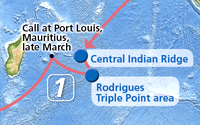 There is active hydrothermal activity in this area, which is a habitat for unusual organisms such as the scaly-foot gastropod , a snail with scales made of iron sulfi des. It is very likely that hydrogen was a source of energy for early life; this marine area has sites spouting hot water with high hydrogen concentrations. The mission here will
be to attempt to understand early evolution by studying the resident organisms.
There is active hydrothermal activity in this area, which is a habitat for unusual organisms such as the scaly-foot gastropod , a snail with scales made of iron sulfi des. It is very likely that hydrogen was a source of energy for early life; this marine area has sites spouting hot water with high hydrogen concentrations. The mission here will
be to attempt to understand early evolution by studying the resident organisms.
Chief Scientists
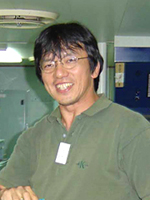
Nobukazu SEAMA
YK13-01 Chief Scientist
Professor
Department of Earth & Planetary Sciences
Graduate School of Science
Kobe University
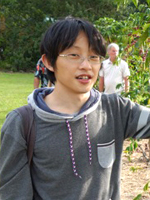
Manabu NISHIZAWA
YK13-02 Chief Scientist
Researcher
Precambrian Ecosystem Laboratory Unit
Laboratory for Earth Systems Science

Kentaro NAKAMURA
YK13-03 Chief Scientist
Researcher
Precambrian Ecosystem Laboratory Unit
Laboratory for Earth Systems Science
Members
| YK13-01 | |
|---|---|
| Nobukazu Seama | (Kobe University) |
| Eri Iizuka | (Kobe University) |
| Akihiro Kouno | (Chiba University) |
| Haruka Shindo | (Kobe University) |
| Yui Noguchi | (Chiba University) |
| Takahiro Baba | (Kobe University) |
| Tetsuo Matsuno | (NIPR) |
| Masayuki Yamaguchi | (JAMSTEC) |
| Tomoaki Yamada | (Earthquake Research Institute,The University of Tokyo) |
| YK13-02 | |
|---|---|
| Manabu Nishizawa | (JAMSTEC) |
| Shinsuke Kawaguchi | (JAMSTEC) |
| Ryuji Kondo | (Fukui Prefectural University) |
| Ken Takai | (JAMSTEC) |
| Kentaro Nakamura | (JAMSTEC) |
| Sayaka Mino | (Hokkaido University) |
| Junichi Miyazaki | (JAMSTEC) |
| Hiromi Watanabe | (JAMSTEC) |
| Tomoo Watsuji | (JAMSTEC) |
| Girish BEEDESSEE | (MOI) |
| Vishwakalyan BHOYROO | (MOI) |
| Prithivi Dass BISSESSUR | (MOI) |
| Modoosoodun KHISHMA | (MOI) |
| S. Leckraz | (Ministry of Agro-Industry, Food Production & Security) |
| YK13-03 | |
|---|---|
| Kentaro Nakamura | (JAMSTEC) |
| Eri Iizuka | (Kobe University) |
| Taichi Sato | (AIST) |
| Toshinori Sato | (Chiba University) |
| Takazo Shibuya | (JAMSTEC) |
| Nobukazu Seama | (Kobe University) |
| Hiroyoshi Takada | (Chiba University) |
| Junichi Miyazaki | (JAMSTEC) |
| Tomoaki Morishita | (Kanazawa University) |
| Tomoo Watsuji | (JAMSTEC) |
Quest-2
The deepest dive of a human-occupied research submersible in the South Atlantic
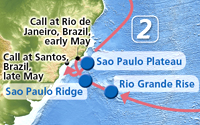 The Rio Grande Rise is an immense ridge, that rises more than 5000 m above the ocean floor in the South Atlantic. This survey will discover how marine communities change with depth and geology. We expect to find a variety of organisms and habitats.
The Rio Grande Rise is an immense ridge, that rises more than 5000 m above the ocean floor in the South Atlantic. This survey will discover how marine communities change with depth and geology. We expect to find a variety of organisms and habitats.
The Sao Paulo Ridge is where material derived from the Earth’s mantle is exposed at the sea floor. Recently, chemosynthetic communities* were discovered in areas surrounding a similar environment in the Marianas Trench in the Western Pacific. We expect to find similar chemosynthetic communities in the Sao Paulo Ridge area.
The Sao Paulo Plateau has extensive natural gas and oil fields, and possibly the world’s most extensive chemosynthetic communities. If chemosynthetic communities are found here, they would be the first discovered in the South Atlantic.
* Chemosynthetic communities: Biological communities based on energy from chemical sources, such as hydrogen sulfide and methane emitted from hydrothermal vents.
Chief Scientists
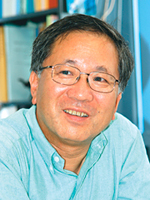
Hiroshi KITAZATO
Research Director
Institute of Biogeosciences (BioGeos)
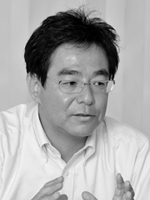
Katsunori FUJIKURA
Team Leader and Principal Scientist
Deep Sea Ecosphere Research Team
Marine Biodiversity Research Program
Institute of Biogeosciences (BioGeos)
Members
| YK13-04 Leg1 | |
|---|---|
| Hiroshi Kitazato | (JAMSTEC) |
| Koichi Ara | (Nihon University) |
| Takashi Toyofuku | (JAMSTEC) |
| Yoshihiro Fujiwara | (JAMSTEC) |
| Peter Christian Hatspaker | (CPRM/IGCE/UNESP Univ. Estadual Paulista) |
| José Angel Alvarez Perez | (University of Vale do Itajaí) |
| Paulo Y.G. Sumida | (Institute of Oceanography, University of São Paulo) |
| Abílio Soares Gomes | (Fluminense Federal University) |
| André Oliveira de Souza Lima | (University of Vale do Itajaí) |
| Eugenio Pires Frazão | (Head of the Marine Geology Division of CPRM) |
| João Marcelo Medina Ketzer | (Pontifical Catholic University of Rio Grande do Sul – PUCRS) |
| YK13-04 Leg2 | |
|---|---|
| Katsunori Fujikura | (JAMSTEC) |
| Shuichi Shigeno | (JAMSTEC) |
| Jing Zhang | (University of Toyama) |
| Yuriko Nagano | (JAMSTEC) |
| Toshiro Yamanaka | (Okayama University) |
| Takao Yoshida | (JAMSTEC) |
| Vivian Helena Pellizari | (Institute of Oceanography, University of São Paulo) |
| Paulo Y.G. Sumida | (Institute of Oceanography, University of São Paulo) |
| Angelo Bernardino | (Federal University of Espírito Santo) |
| Antonio Fernando Menezes Freire | (PETROBRAS) |
| Cristina Rossi Nakayama | (Federal University of São Paulo) |
| José Adilsn Dias Cavalcate | (Head of the Marine Geology Division of CPRM) |
Quest-1
Are there organisms living at 400°C at deep hydrothermal fields?
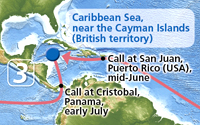 The Cayman Rise is said to have 400°C seawater spouting from hydrothermal vents. Here we will survey the habitable limits of life and reveal survival strategies in extreme
environments, such as symbiosis between macro- and microorganisms.
The Cayman Rise is said to have 400°C seawater spouting from hydrothermal vents. Here we will survey the habitable limits of life and reveal survival strategies in extreme
environments, such as symbiosis between macro- and microorganisms.
At one time the Pacific and Atlantic oceans were connected, and there was exchange of organisms between them.
However, 3 million years ago a land bridge connected South and North America, separating the two oceans and isolating the resident organisms from each other. We will survey how organisms originating in the Pacific evolved in the Atlantic, and explore their adaptations and subsequent evolution.
Chief Scientist
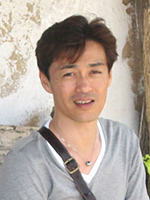
Ken TAKAI
Program Director
Extremobiosphere Research Program
Institute of Biogeosciences (BioGeos)
Members
| YK13-05 | |
|---|---|
| Ken Takai | (JAMSTEC) |
| Shinsuke Kawaguchi | (JAMSTEC) |
| Junichi Miyazaki | (JAMSTEC) |
| Norio Miyamoto | (JAMSTEC) |
| Katsunori Yanagawa | (JAMSTEC) |
| Takuya Yahagi | (University of Tokyo) |
| Hiromi Watanabe | (JAMSTEC) |
| Danielle Morgan Smith | (East Carolina University) |
| Diva Joan Amon | (University of Southampton) |
| Jonathan Timothy Peter Copley | (University of Southampton) |
| Priya Narasingarao | (Scripps Institute of Oceanography) |
| Verity Ellen Nye | (University of Southampton) |
Quest-1
To the world’s second-deepest submarine trench
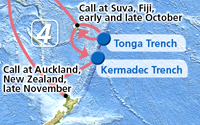 At JAMSTEC, we have investigated the Challenger Deep in the Marianas Trench, the deepest known point in the world’s oceans (10,911 m). However, we have not yet investigated the world’s second-deepest trench - the Tonga Trench (10,850 m depth). By investigating the Tonga Trench and comparing the deepest and the second-deepest areas in the world’s oceans, we will be closer to understanding ultra-deep-sea ecosystems.
At JAMSTEC, we have investigated the Challenger Deep in the Marianas Trench, the deepest known point in the world’s oceans (10,911 m). However, we have not yet investigated the world’s second-deepest trench - the Tonga Trench (10,850 m depth). By investigating the Tonga Trench and comparing the deepest and the second-deepest areas in the world’s oceans, we will be closer to understanding ultra-deep-sea ecosystems.
The Louisville Seamount Chain is quickly subducting into the Tonga and Kermadec trenches. We will investigate a number of these seamounts to find out how communities change with depth.
Chief Scientists

Hiroshi KITAZATO
Research Director
Institute of Biogeosciences (BioGeos)
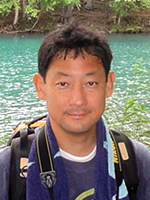
Shinji TSUCHIDA
Technical Scientist
Deep Sea Ecosphere Research Team
Marine Biodiversity Research Program
Institute of Biogeosciences (BioGeos)